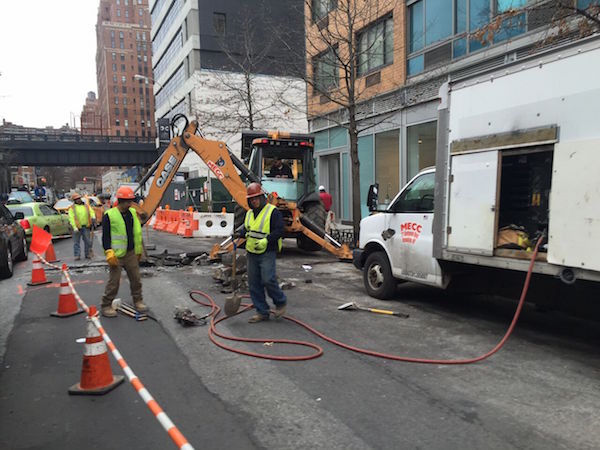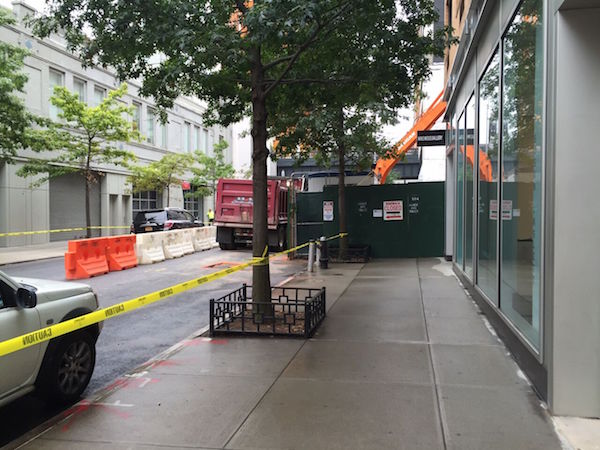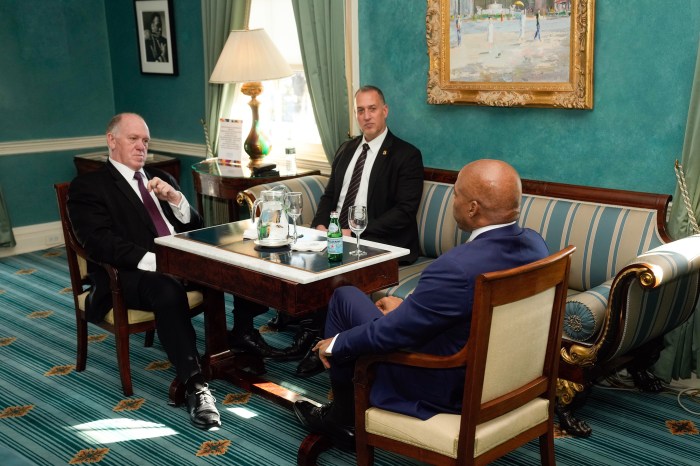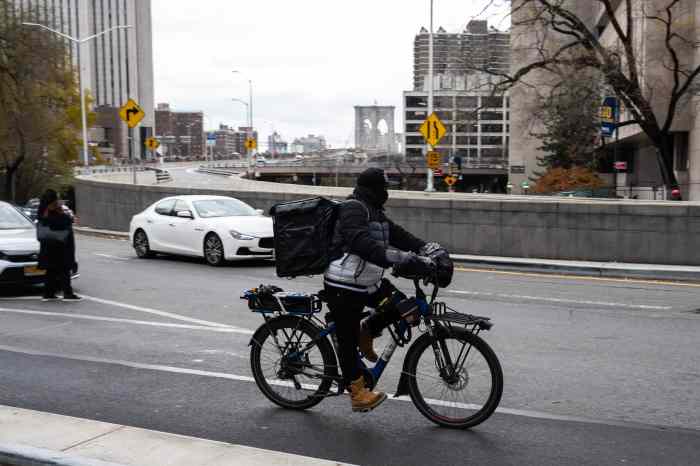
BY DENNIS LYNCH | Mike Weiss closed his eponymous Chelsea gallery earlier this month, following a drawn-out ordeal with a demolition operation next door at the soon-to-be Fitzroy luxury condominiums — a process he said drove away potential customers and caused material damages to his gallery and artwork.
The decision to end his 13-year presence on W. 24th St. comes after Weiss claimed $7.5 million in damages in a civil suit against JDS Development Group and Largo Investments, which are in charge of the project at 514 W. 24th St. (btw. 10th & 11th Aves.). Weiss claimed material damages consistently occurred during demolition — including cracked walls caused by the vibration of heavy equipment, dust damage to artwork, and water damage caused by an oft-improperly attended fire hydrant in front of the gallery that was used by the demolition crew.
Weiss also claimed that excessive noise made it difficult to conduct business with prospective clients, and dust kept people away and endangered his employees. A barrier around his gallery door, debris outside, and construction equipment parked outside also discouraged foot traffic, he said, causing a dramatic drop in walk-ins.
“I can’t tell you how many weeks people said ‘I can’t be here, its too loud,’ or that it smells like something weird — we saw a 90 percent drop in traffic to our gallery,” Weiss said. “And it’s not just the money problems. You can’t hear yourself on the phone; employees are unhappy. The artists have been very supportive, but it’s very difficult.”
Weiss had seven years left on his lease at the space and has not decided whether or not he will re-open the gallery somewhere else, or sell privately instead. He ended his tenure at 520 W. 24th St. on Oct. 8, with “Where Do We Dump The Bodies?” — an aptly titled exhibition of Dan Schein’s paintings.
Weiss said he had an easier time dealing with damage from Hurricane Sandy than the damage he claimed in the suit — most of the damages were paid for out of pocket, and some through his insurance. In all, Largo Investments and JDS paid to move a security camera they blocked during demolition, for a sign to hang on scaffolding outside, and for water damage once — although Weiss said water consistently got into the gallery.

In August, he put the suit on hold because of mounting legal fees. The development team strongly refuted Weiss’s claims in the suit, calling it “frivolous.”
“The Fitzroy has not been issued any violations by the Department of Buildings related to the numerous baseless complaints from the Mike Weiss Gallery. Additionally, the frivolous injunction filed by the gallery was withdrawn,” an Oct. 14 email statement to Chelsea Now said. “The partnership behind The Fitzroy has a long history developing and building successful projects that enhance their neighborhoods with minimal impact to their immediate surroundings… JDS Development Group & Largo Investments do not take their responsibilities as good neighbors lightly…”
Weiss filed dozens of complaints through 311 and a handful to the Department of Buildings regarding the operation. He also appealed to City Councilmember Corey Johnson’s office and the mayor’s office, but said he received little to no support from them. Johnson’s staff has been in touch with Weiss since news broke of the gallery’s closure, to help him navigate potentially helpful state resources.
In January, the Fitzroy partnership’s insurance company hired an independent adjustor to determine damages at the gallery. The adjustor found the demolition company — headquartered at the same address as both the construction company and the LLC that owns the Fitzroy property — “created the condition, did not take the proper measures to protect their work and the neighboring property,” and was liable for damages. Weiss estimated his damages totaled around $100,000 at that time.
The Department of Buildings has issued 10 violations on the job at the Fitzroy since September of last year. Two are still open, although it is unclear if any of those were related to Weiss’s complaints. Records show two were because a safety manager was absent at the time of inspection. Other violations include improper storage of compressed gas, inaccessible temporary pedestrian walkways, and a failure to provide plans for mechanical demolition.
Ironically, the partnership cited West Chelsea’s “world-renown [sic] art galleries” as part of what makes the neighborhood “one of Manhattan’s most vibrant,” on the building’s website. Luckily for future Fitzroy residents, Mike Weiss Gallery is the only gallery on W. 24th St. to shut down because of the demolition and construction. So far it’s been more a nuisance rather than an existential threat to the others on the street, according to gallery employees and owners who spoke with us.

“We’ve gotten used to it — for people who work or visit, it becomes part of life,” an employee of a gallery on the north side of the street said. “Traffic is still the same, if there’s any place that can remain prosperous, it’s 24th Street.”
Irene Cassina, owner of Cassina Projects (508 W. 24th St., directly next to the demolition project), said it only caused a dip in traffic “a few days here and there,” but that equipment or barriers never blocked her entrance. A block away, the reconstruction of a sidewalk in front of Nancy Margolis Gallery (523 W. 25th St., btw. 10th & 11th Aves.) slowed down business, but the owner has so far weathered the storm.
“We did realize we weren’t having as much traffic,” Margolis said. “At one point there was a dumpster parked right out front sort of blocking us, but we spoke to them and they moved it. You pay a lot of money to be here because there is a lot of foot traffic, but its not going to shut me down.”
Construction seems to “disrupt” the flow of walking traffic around the neighborhood, according to Scotto Mycklebust — a longtime Greenwich Village resident, Chelsea-based studio artist, and founder/producer of West Chelsea Artists Open Studios and the High Line Open Studios. He spoke of a construction project on 10th Ave. that required a large crane to be parked on the street.
“It definitely makes you more cautious. Before, you felt like you can walk around freely from gallery to gallery; it’s definitely disrupted that, no question about that,” Mycklebust said.
But it is hard to quantify its tangible effect on the local art scene, which has shrunk in recent years anyways, Mycklebust noted. His most recent open studio event featured about a third of the artists he had when he first got involved in 2011. He pinned that on rising rents, which he doesn’t think will level any time soon, especially when a certain mega-project up the street is finished.
“At least four galleries left, including three ‘blue chip’ galleries — it’s a combination of new buildings being built, construction, increased rent,” he said. “Once they get Hudson Yards finished that’ll bring 10,000 new workers and that will have a huge effect on rents in the neighborhood.”





































